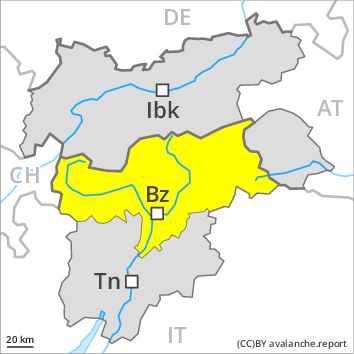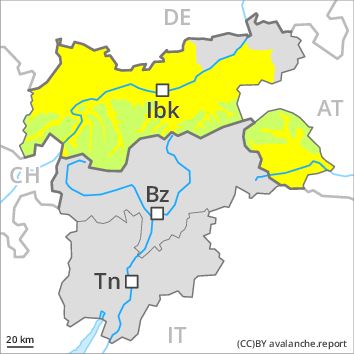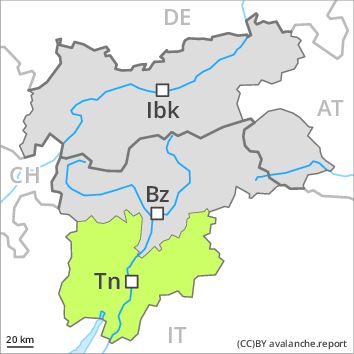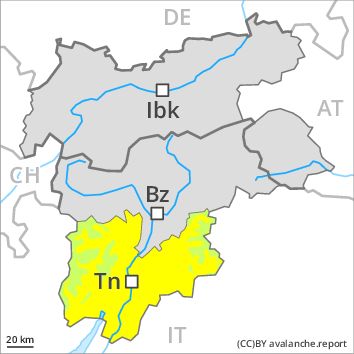Regions
Sexten Dolomites, Eastern Pfunderer Mountains, Durreck Range, Western Rieserferner Mountains, Val Müstair Alps, Western Deferegger Alps, Langtaufers, Ortler Range, Schnals Ridge, Southern Stubai Alps, Ulten Valley, Southern Zillertal Alps and High Tauern, Eastern Nonsberger Alps, Northern Dolomites of Fiemme, Saldurn-Mastaun Ridge, Gröden Dolomites, Texel Mountains, Prags Dolomites, Sarntal Alps, Western Pfunderer Mountains
AM

Danger level
Danger Level 1 - Low
PM

Danger level
Danger Level 2 - Moderate
Avalanche Problem
Wet snow above 2800m, N-NE-E-SE-S-SW-W-NW
Natural wet avalanches as the day progresses.
The Avalanche Warning Service currently has only a small amount of information that has been collected in the field.
Caution is to be exercised on very steep shady slopes as well as adjacent to ridgelines and in pass areas at high altitudes and in high Alpine regions.
As a consequence of warming during the day and the solar radiation, the likelihood of moist and wet avalanches being released will increase gradually. As the day progresses small and, in isolated cases, medium-sized moist and wet avalanches are possible below approximately 2800 m. From origins in starting zones where no previous releases have taken place moist and wet avalanches are possible, even quite large ones. Exposed parts of transportation routes can be endangered occasionally in the regions with a lot of snow.
Snowpack
dp 10: springtime scenario
Isolated avalanche prone weak layers exist in the old snowpack especially on very steep shady slopes.
Outgoing longwave radiation during the night will be good. The surface of the snowpack will freeze to form a strong crust and will soften during the day. The weather will be mild. As the penetration by moisture increases the prevalence and size of the avalanche prone locations will increase on Monday.
Tendency
Increase in danger of wet and gliding avalanches as a consequence of warming during the day and solar radiation.
Regions
Western Verwall Mountains, Eastern Verwall Mountains, Silvretta, Samnaun Mountains, Northern Oetz and Stubai Alps, Western Tuxer Alps, Eastern Tuxer Alps, Western Kitzbühel Alps, Glockturm Range, Weißkugel Range, Gurgler Range, Central Stubai Alps, Northern Zillertal Alps, Allgäu Alps, Venediger Range, Eastern Lechtal Alps - Ammergau Alps, Mieming Mountains, Eastern Rieserferner Mountains, Karwendel Mountains, Glockner Range, Eastern Deferegger Alps, Schober Mountains, Lienzer Dolomites, Western Lechtal Alps, Central Lechtal Alps, Grieskogel Mountains
AM

Danger level
Danger Level 1 - Low above 2800m
Danger Level 1 - Low above 2800m
PM

Danger level
Danger Level 1 - Low above 2800m
Danger Level 2 - Moderate above 2800m
Avalanche Problem
Gliding snow above 2600m above 1600m, E-SE-S-SW-W
Wet snow above 2800m, E-SE-S-SW-W
Slight increase in avalanche danger as a consequence of warming during the day and solar radiation.
The Avalanche Warning Service currently has only a small amount of information that has been collected in the field.
The avalanche conditions in the morning are favourable.
Midday and afternoon: Slight increase in avalanche danger as a consequence of warming during the day and solar radiation. Gliding avalanches and wet snow slides are the main danger. The avalanche prone locations are to be found in particular on very steep sunny slopes below approximately 2800 m. These places are rather rare and are easy to recognise.
In addition a low (level 1) danger of dry slab avalanches exists. This applies in particular on extremely steep shady slopes above approximately 2400 m. The avalanches are rather small and can be released by large loads.
Snowpack
dp 2: gliding snow
dp 10: springtime scenario
The surface of the snowpack has frozen to form a strong crust and will soften during the day. This applies in particular on sunny slopes.
The somewhat older wind slabs are lying on weak layers in particular on shady slopes at high altitude. Such avalanche prone locations are rare.
The old snowpack will be in most cases stable. At intermediate altitudes hardly any snow is lying. At low altitude no snow is lying.
Tendency
Slight increase in danger of gliding avalanches and snow slides as a consequence of warming during the day and solar radiation.
Regions
Latemar, Southern Adamello, Primiero - Pale di S. Martino, Adamello - Presanella, Prealps, Northern Brenta - Peller, Cembra Valley, Bondone and Stivo, Vallarsa, Western Nonsberg Alps, Folgaria - Laverone, Southern Brenta, Fassa Valley, Sole, Pejo and Rabbi, Southern Lagorai, Ledro Valley, Northern Lagorai, Maddalene, Paganella, Marzola - Valsugana, Pine' - Mocheni Valley
AM

Danger level
Danger Level 1 - Low above 2800m
Danger Level 1 - Low above 2800m
PM

Danger level
Danger Level 1 - Low above 2800m
Danger Level 2 - Moderate above 2800m
Avalanche Problem
Wet snow above 2800m, N-NE-E-SE-S-SW-W-NW
Gliding snow above 2800m, E-SE-S-SW-W
Natural wet avalanches as the day progresses.
The Avalanche Warning Service currently has only a small amount of information that has been collected in the field.
Caution is to be exercised on very steep shady slopes as well as adjacent to ridgelines and in pass areas at high altitudes and in high Alpine regions.
As a consequence of warming during the day and the solar radiation, the likelihood of moist and wet avalanches being released will increase gradually. As the day progresses small and, in isolated cases, medium-sized moist and wet avalanches are possible below approximately 2800 m. From origins in starting zones where no previous releases have taken place moist and wet avalanches are possible, even quite large ones.
Exposed parts of transportation routes can be endangered occasionally in the regions with a lot of snow.
Snowpack
dp 10: springtime scenario
dp 2: gliding snow
Isolated avalanche prone weak layers exist in the old snowpack especially on very steep shady slopes.
Outgoing longwave radiation during the night will be good. The surface of the snowpack will freeze to form a strong crust and will soften during the day. The weather will be mild. As the penetration by moisture increases the prevalence and size of the avalanche prone locations will increase on Monday.
Tendency
Increase in danger of wet and gliding avalanches as a consequence of warming during the day and solar radiation.
Regions
Brandenberg Alps, Wilder Kaiser Mountains - Waidring Alps, Eastern Kitzbühel Alps

Danger level
Danger Level 1 - Low

Slight increase in avalanche danger as a consequence of warming during the day and solar radiation.
The Avalanche Warning Service currently has only a small amount of information that has been collected in the field. The avalanche conditions are mostly favourable.
Midday and afternoon: Slight increase in avalanche danger as a consequence of warming during the day and solar radiation. Moist snow slides are the main danger. The avalanche prone locations are to be found in particular on extremely steep sunny slopes at high altitude.
Snowpack
The surface of the snowpack has frozen to form a strong crust and will soften during the day. This applies in particular on sunny slopes.
The old snowpack will be in most cases stable. At intermediate altitudes hardly any snow is lying. At low altitude no snow is lying.
Tendency
Slight increase in danger of moist snow slides as a consequence of warming during the day and solar radiation.







